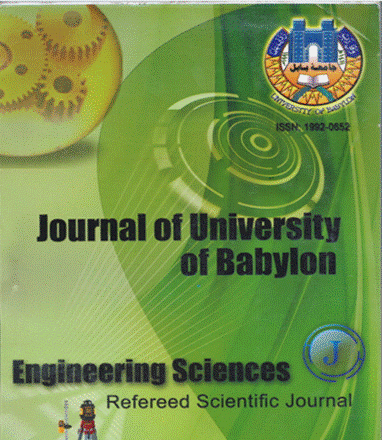Abstract
The present study was conducted to evaluate the risk of water supply system in Babylon Governorate from the intake through to the consumer's tap. Water failure may occur at any components of water supply system. Therefore, risk was calculated for exposure to contaminants in raw, treated, and distributed tap water.
The risk assessment process was concerned on chemical and microbial contaminants in water. The hazard index (HI) was calculated for noncarcinogenic chemicals (Hg, Cd, Cu, Zn, NO3, and Cl(free)) in water , while the risk was calculated for carcinogenic chemicals (Pb, As, and Cr) and microbial contaminant represented E.coli. Both of hazard index and risk were conducted for raw, treated, and distributed tap water and the results were compared with the EPA limitations in order to show the potential health risks of these chemicals to local primary users of water from water supply system.
In this study the statistical models which are described the relations between the water quality parameters and human health were established, the statistical analysis results revealed significant correlation between the number of infections of cholera, diarrhea, typhoid and hepatitis disease with water quality parameters of raw, treated , and distributed tap water.
The risk assessment process was concerned on chemical and microbial contaminants in water. The hazard index (HI) was calculated for noncarcinogenic chemicals (Hg, Cd, Cu, Zn, NO3, and Cl(free)) in water , while the risk was calculated for carcinogenic chemicals (Pb, As, and Cr) and microbial contaminant represented E.coli. Both of hazard index and risk were conducted for raw, treated, and distributed tap water and the results were compared with the EPA limitations in order to show the potential health risks of these chemicals to local primary users of water from water supply system.
In this study the statistical models which are described the relations between the water quality parameters and human health were established, the statistical analysis results revealed significant correlation between the number of infections of cholera, diarrhea, typhoid and hepatitis disease with water quality parameters of raw, treated , and distributed tap water.
Abstract
أجريت الدراسة الحالية لتقييم الخطر في نظام تجهيز المياه في محافظة بابل من المصدر إلى حنفية المستهلك. وان حدوث الفشل محتمل في أي مكون من مكونات نظام تجهيز المياه لذا تم حساب خطر التعرض للملوثات في المياه الخام والمعالجة والمستهلكة.
أجريت عملية تقييم الخطر للملوثات الكيميائية والميكروبية في المياه، للمواد غير المسرطنة (الزئبق ، الكادميوم ، النحاس، النترات والكلورين الحر ) وذلك بحساب مؤشر الخطر . بينما تم حساب الخطر للمواد المسرطنه ( الرصاص، الزرنيخ، والكروم ) والملوثات المكروبية المتمثلة بالبكتريا البرازية وان كلا″ من مؤشر الخطر والخطر حسب للمياه الخام والمعالجة والمستهلكة ومن ثم تمت مقارنة النتائج مع محددات وكالة حماية البيئة لتوضيح الأخطار المحتملة للملوثات على صحة السكان المحليين الذين يستخدمون المياه من نظام تجهيز المياه.
في هذه الدراسة وضعت الموديلات الاحصائيه لتوضيح تأثير المياه الملوثة على صحة الإنسان . كشفت نتائج التحليل الإحصائي بوجود ارتباط معنوي بين عدد الإصابات لمرض الكوليرا، الإسهال، التيفوئيد والتهاب الكبد الفيروسي مع خصائص المياه الخام والمعالجة والمستهلكة .
أجريت عملية تقييم الخطر للملوثات الكيميائية والميكروبية في المياه، للمواد غير المسرطنة (الزئبق ، الكادميوم ، النحاس، النترات والكلورين الحر ) وذلك بحساب مؤشر الخطر . بينما تم حساب الخطر للمواد المسرطنه ( الرصاص، الزرنيخ، والكروم ) والملوثات المكروبية المتمثلة بالبكتريا البرازية وان كلا″ من مؤشر الخطر والخطر حسب للمياه الخام والمعالجة والمستهلكة ومن ثم تمت مقارنة النتائج مع محددات وكالة حماية البيئة لتوضيح الأخطار المحتملة للملوثات على صحة السكان المحليين الذين يستخدمون المياه من نظام تجهيز المياه.
في هذه الدراسة وضعت الموديلات الاحصائيه لتوضيح تأثير المياه الملوثة على صحة الإنسان . كشفت نتائج التحليل الإحصائي بوجود ارتباط معنوي بين عدد الإصابات لمرض الكوليرا، الإسهال، التيفوئيد والتهاب الكبد الفيروسي مع خصائص المياه الخام والمعالجة والمستهلكة .
